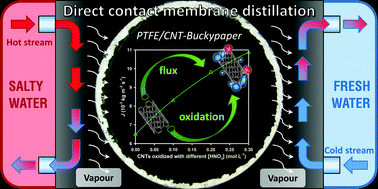Modification of the surface chemistry of single- and multi-walled carbon nanotubes by HNO3 and H2SO4 hydrothermal oxidation for application in direct contact membrane distillation†
Abstract
A specific methodology based on nitric acid hydrothermal oxidation was used to control the surface chemistry of multi-walled (MWCNTs) and single-walled (SWCNTs) carbon nanotubes (CNTs) with different lengths, and this methodology was adapted to the use of sulphuric acid containing ammonium persulfate as an oxidizing agent. The amount of oxygen-containing surface groups depends on the number and length of the graphene layers of the CNTs, thicker and shorter CNTs having more reactive sites for surface functionalization. In particular, the oxidation of MWCNTs was more pronounced than that of short SWCNTs and less surface groups were introduced into long SWCNTs, regardless of the acid used at any fixed concentration. It was also possible to tailor the surface chemistry of both SWCNTs and MWCNTs by using the adopted methodologies, and the amount of both oxygen- and sulphur-containing functional groups was correlated with the concentration of each oxidizing agent used. Mathematical functions that allow precise control of the amount and type of the surface groups introduced into carbon nanotubes were obtained. Buckypapers were also prepared over a polytetrafluoroethylene commercial membrane. These membranes were tested in direct contact membrane distillation and, under salinity conditions, the membrane prepared using oxidized MWCNTs (instead of SWCNTs) was the most efficient, the permeate flux of the commercial membrane significantly increasing in the presence of these CNTs, while completely rejecting chloride ions. In addition, the permeate flux was precisely correlated with the amount of oxygenated functional surface groups (as well as with the pH of point of zero charge) of the oxidized MWCNTs.


 Please wait while we load your content...
Please wait while we load your content...